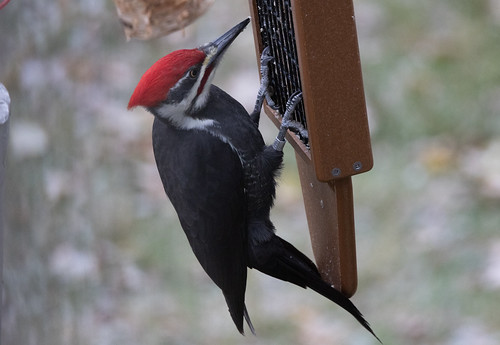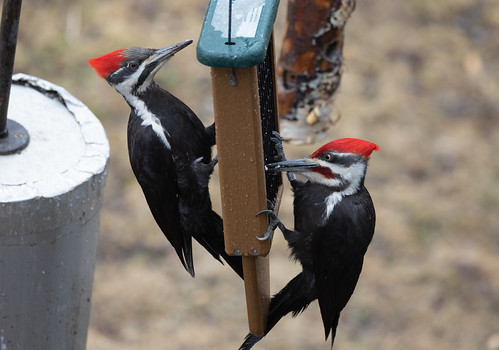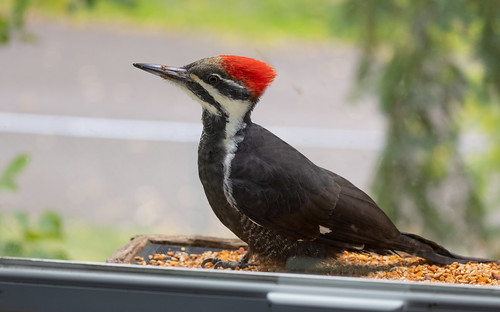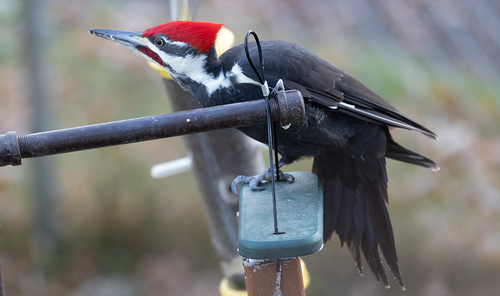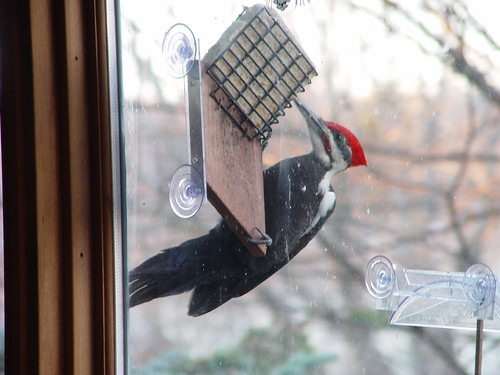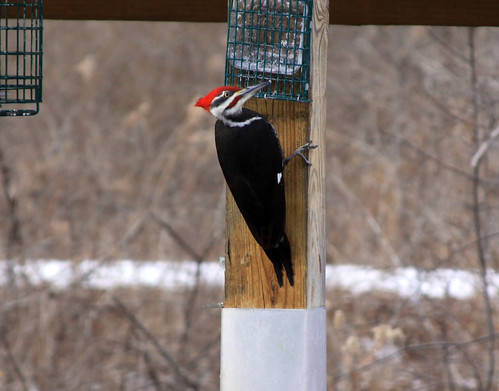For the past year, I’ve been doing my best to keep track of one particular Pileated Woodpecker that I call BB, or Banded Boy. Frank Nicoletti banded him as an immature at Hawk Ridge last year.
From the start, BB seemed like an old pro at using a bird feeder and is very laid back in my yard—last November he tolerated a whole lot of birders coming over to see a Rufous Hummingbird, and he doesn’t bolt from the feeder when my neighbor is mowing the lawn or when people and dogs walk by just past the fence, 15 or 20 feet away. And BB ignores me when I open a window and stick my long camera lens out. He kept coming frequently through this past April. Then he seemed to hook up with a female.
BB and his lady love stopped coming soon after I photographed them together, and I had very few Pileated sightings in my yard all summer. BB reappeared on September 3. Since then, I’ve also been seeing at least two female Pileateds, somewhat regularly. Oddly enough, they feed not only at the suet feeders but visited my window seed feeder for a couple of weeks.
On Sunday, October 30, I was watching BB in the suet feeder when suddenly a second male Pileated appeared on the cross-pole supporting the suet feeder, his face just a couple feet from BB’s. BB ignored him for a minute or two, but when the new guy started pecking on a wire nearer the suet feeder, BB flew up at him, and then flew away.
That left the new kid on the block with the feeder all to himself. I always thought that suet feeders must be a little intuitive for woodpeckers, and it’s not like this new guy hadn’t watched BB on the feeder for at least a little while, but he simply could not figure it out.
First he sat on the supporting pole and leaned down to take tiny bits of suet. That didn’t give him much food, so he jumped on top of the feeder but it was too slippery, so he grabbed on to the pole with one foot and straddled, sticking his tongue into the little holes holding the supporting wires, not getting much food at all. He did not sit vertically on the feeder the way woodpeckers normally do, and finally gave up and flew away.
That was on Sunday. Since then, we haven’t seen him, but meanwhile BB has been coming several times a day, possibly making sure the new kid on the block isn’t trying to take over BB's favorite feeding station.
It surprised me that the unbanded male didn’t know how to get food from a suet feeder, and made me curious about how Pileateds normally figure feeders out. Back in 2004, a male Pileated visited my small window suet feeder repeatedly for a few months.
But otherwise Pileateds just did not come to feeders in my yard or my mother-in-law’s in rural Port Wing, Wisconsin. I saw them at feeders here and there in Minnesota, Wisconsin, and Ithaca, New York when I worked at Cornell,
But I haven’t figured out whether those individuals had figured out feeders on their own, watched other Pileateds or other species of woodpeckers, or learned from their parents. I’ve had several different individuals coming to my feeder consistently for the past several years, so however each individual figured it out, it’s become pretty normal here. But as the new kid on the block shows, how you get food out of a suet feeder doesn’t appear to be intuitive, at least not to every Pileated. I’d love to ask BB how he figured it out. He’s pretty tolerant of me, but I suspect he will not give me a straight answer.

